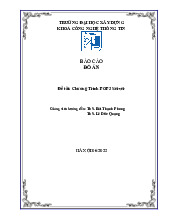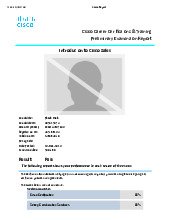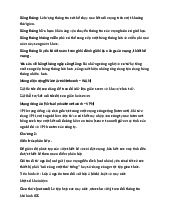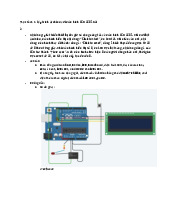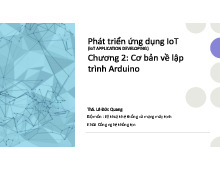



















Preview text:
lOMoAR cPSD| 58970315 lOMoAR cPSD| 5897031 5
Table of Contents
What This Guide Can Do for You 1
Education Networking Examples 14
The Building Blocks: Basic Components of Networks 2
A Local-Area Network at a Campus 14 Clients and Servers 2 As the Campus Network Grows 15
A Wide-Area Network for a Small District 16 Wiring and Cable 3 A Community College WAN 16 Network Interface Cards 3 Hubs 4
Making the Right Connection: Network How-Tos 17
Margin Note: Network Management 4
How to Connect to the Internet 17 Margin Note: Modems 4
How to Choose an Internet Service Provider 19
How to Create Your Own Web Site 20 Switches 5
Margin Note: Instant Web Content for Education 20 Routers 5 Margin Note: Security 20
Margin Note: Uninterruptible Power Supplies 6 Margin Note: Bridges 6
Basic Network Design: Considerations 21
Networking Technologies Overview 7
A Problem Solvers’ Guide to Relieving Congestion 21
How to Spot Network Congestion 21
Local-Area Networks: Ethernet and Fast Ethernet 7
Good Network Design: The 80-20 Rule 23
Remote Access and Wide-Area Networks 9
Giving Your Network a Performance Boost 24 Margin Note: Token Ring 9
Dedicated Bandwidth to Workgroups and Servers 25
Margin Note: High-Speed LAN Technologies 9
Margin Note: Types of Ethernet Traffic 25 Making the Most of Your Analog Lines 10
Existing Equipment as Your Network Evolves 26
Margin Note: Analog vs. Digital 10 ISDN 11
Networking Basics Checklist 27
Margin Note: Modems vs. Routers 11 For Building a Small LAN 27
For Connecting Buildings on a Campus 27
For Connecting to Another Campus or District 28
Margin Note: Training and Support 28 Glossary 29 Who Is Cisco Systems? 31 lOMoAR cPSD| 5897031 5 Leased Lines 12
Margin Note: The Universal Service Fund, or E-Rate 12
Margin Note: Fund-Raising for Networking Projects 12
Margin Note: Remote Access Servers 12
Which Service Is Right for You? 13 lOMoAR cPSD| 58970315
What This Guide Can Do for You lOMoAR cPSD| 58970315
The Building Blocks: Basic Components of Networks
There are as many definitions for the term “network” as there • At least two computers
are networks. However, most people would agree that networks
• A network interface on each computer (the device thatlets
are collections of two or more connected computers. When their
the computer talk to the network—usually called a network
Most networks—even those with just two computers—also
have a hub or a switch to act as a connection point between the computers.
Basic Networking Components
computers are joined in a network, people can share files and
interface card [NIC] or adapter)
peripherals such as modems, printers, tape backup drives, and
• A connection medium—usually a wire or cable, but wireless
CD-ROM drives. When networks at multiple locations are
communication between networked computers and
connected using services available from phone companies, peripherals is also possible
people can send e-mail, share links to the global Internet, or
• Network operating system software—such as
conduct videoconferences in real time with other remote users
MicrosoftWindows 95 or Windows NT, Novell NetWare, on the network.
AppleShare, or Artisoft LANtastic Every network includes: Clients and Servers Wiring and Cable
Often, as a network grows and more computers are added, one
computer will act as a server—a central storage point for files or
application programs shared on the network. Servers also
provide connections to shared peripherals such as printers.
Setting up one computer as a server prevents you from having
to outfit every networked computer with extensive storage Twisted Pair Coaxial Fiber-Optic
capability and duplicate costly peripherals. The computers that
connect to the server are called clients.
Note that you don’t need to have a dedicated server in your
Networks use three primary types of wiring (also referred to as
network. With only a few computers connected, networking “media”):
can be “peer to peer.” Users can exchange files and e-mail,
Twisted-pair—the industry standard in new installations. This
copy files onto each others’ hard drives and even use printers
wire comes in several “standards.” Unshielded twisted pair (UTP)
or modems connected to just one computer. As more users are
Category 3 wire (also called 10BaseT) is often used for your
added to the network, however, having a dedicated server
phone lines, and UTP Category 5 (also called 10Base2) wire are
provides a central point for management duties such as file
the current networking standards. backup and program upgrades.
Coaxial—resembles round cable TV wiring. lOMoAR cPSD| 58970315
Fiber-optic—usually reserved for connections between
architect or wiring contractor to ensure this process is fire code
“backbone” devices in larger networks, though in some very compliant.
demanding environments, highly fault resistant fiberoptic cable Network interface cards
is used to connect desktop workstations to the network and to
Network interface cards (NICs), or adapters, are usually
link adjacent buildings. Fiber-optic cable is the most reliable
installed inside a computer’s
wiring but also the most expensive. case. With portable and notebook
Care should be taken in selecting the cabling for your computers, the NIC is
classrooms and buildings. You want to be sure the wires Network Interface Card
running through ceilings and between walls can handle not
usually in the credit cardsized PC card (PCMCIA) format, which
only your present needs, but any upgrades you foresee in the
is installed in a slot. Again, when selecting NICs, plan ahead.
next several years. For instance, Ethernet can use UTP Category
Ethernet NICs support only Ethernet connections, while 10/100
3 wiring. However, Fast Ethernet requires at least the higher-
NICs cost about the same and can work with either Ethernet or
grade UTP Category 5 wiring. As a result, all new wiring
higher-performance Fast Ethernet connections. In addition,
installations should be Category 5. You may also want to
you need to ensure that your NICs will support the type of
explore plenum cable, which can be routed through many
cabling you will use—twisted-pair (also called 10BaseT), coaxial
types of heating and cooling ducts in ceilings. Check with your
(also called 10Base2), or a mixture of both. lOMoAR cPSD| 58970315 one port from one work- series
signal. The receiving modem converts the analog signal back Internet lOMoARcPSD|58970315 Switches
Examples of Cisco switch products:
Switches are smarter than
Cisco 1548 Micro Switch 10/100 hubs and offer more Cisco Catalyst® Series bandwidth. A switch Routers forwards data packets only Compared to switches and to the
bridges, routers are smarter Switch still. Routers
appropriate port for the intended recipient, based on use a more complete packet
information in each packet’s header. To insulate the “address” to
transmission from the other ports, the switch establishes a Router
temporary connection between the source and destination,
determine which router or workstation should receive each
then terminates the connection when the conversation is
packet. Based on a network roadmap called a “routing table,” done.
routers can help ensure that packets are traveling the most
As such, a switch can support multiple “conversations” and
efficient paths to their destinations. If a link between two
move much more traffic through the network than a hub. A single
routers goes down, the sending router can determine an
eight-port Ethernet hub provides a total of 10 megabits per
alternate route to keep traffic moving.
second (Mbps) of data-carrying capacity shared among all users
Routers also provide links between networks that speak
on the hub. A “full-duplex,” eight-port Ethernet switch can
different languages—or, in computer speak—networks that use
support eight 10-Mbps conversations at once, for a total data-
different “protocols.” Examples include IP (Internet Protocol), the
carrying capacity of 160 Mbps. “Full-duplex” refers to
IPX® (Internet Packet Exchange Protocol), and AppleTalk. Routers
simultaneous two-way communications, such as telephone
not only connect networks in a single location or set of buildings,
communication. With half-duplex communications, data can
but they provide interfaces—or “sockets”—for connecting to
move across the cable or transmission medium in just one
wide-area network (WAN) services. These WAN services, which direction at a time.
are offered by telecommunications companies to connect
geographically dispersed networks, are explained in more detail in the next chapter. lOMoAR cPSD| 58970315
As the network becomes crowded with users or traffic, are basically multiple
” (the spine that connects various segments
or “subnetworks”). If a user sends a message to someone in
the backbone. In today’s networks, switches are used where
Networking Technologies Overview
cause congestion. Files take longer to print, applications take
longer to open, and users are forced to wait. At 60 percent or
higher bandwidth usage, the network can slow dramatically or even grind to a halt. Local-Area Networks: Ethernet and Fast Ethernet
Ethernet has been around since the late 1970s and remains the
leading network technology for local-area networks (LANs). (A
LAN is a network contained in a building or on a single campus.)
Ethernet is based on carrier sense multiple access with collision
detection (CSMA/CD). (See the margin note on Token Ring for
another basic style of network communication.)
Simply put, an Ethernet workstation can send data packets
only when no other packets are traveling on the network, that
is, when the network is “quiet.” Otherwise, it waits to transmit,
just as a person might wait for another to speak during conversation.
If multiple stations sense an opening
and start sending at the same time, a
“collision” occurs. Then, each station waits a
random amount of time and tries to send its
packet again. After 16 consecutive failed
attempts, the original application that sent
the packet has to start again. As more
people try to use the network, the number
of collisions, errors, and subsequent
retransmits grows quickly, causing a snowball effect.
Collisions are normal occurrences, but
too many can start to cause the network to slow down. When more
than 50 percent of the network’s total
bandwidth is used, collision rates begin to lOMoAR cPSD| 58970315 Ethe r lOMoAR cPSD| 58970315
As noted in the previous section, Ethernet’s bandwidth or data-
carrying capacity (also called throughput) is 10 Mbps. Fast Ethernet
(or 100BaseT) works the same way—through collision detection—
but it provides 10 times the bandwidth, or 100 Mbps.
Shared Ethernet is like a single-lane highway with a 10- Mbps
speed limit (see diagrams below). Shared Fast Ethernet is like a much wider
highway with a 100-Mbps speed limit; there is more room for cars, and
they can travel at higher speeds.What would Switched Ethernet look like? A
multilane highway with a speed limit of 10 Mbps in each lane.
Switched Fast Ethernet also would be a multilane highway, but with a speed limit of 100 Mbps in each lane. netSwitched Fast Ethernet lOMoAR cPSD| 58970315
FastDownloaded by Nguyen Linh (nguyenlinh31082025@gmail.com) Token Ring
more quickly and offer greater data-carrying capacity than
Token Ring is a “token-passing” technology and an alternative to Ethernet,
Ethernet’s collision-detection method. A token travels through
Fast Ethernet, or Token Ring. Fiber Distributed Data Interface
the network, which must be set up in a closed ring, and stops at
(FDDI) is another “token-passing” technology, operating at 100
each workstation to ask whether it has anything to send. If not,
Mbps. But because it requires different wiring (fiber) and
the token continues to the next point on the network. If there is
different hubs and switches from Ethernet, FDDI is losing ground
data to send, the sending station converts the token frame into
to Fast Ethernet and other high-speed technologies.
a data frame and places it into the ring. The frame continues Asynchronous
around the ring, sets repeated by all stations, but the
Transfer Mode (ATM) operates at a range of speeds up to 622
destination station also copies the frame into memory. When
Mbps. It is a popular choice for the backbones of extremely
the frame comes around to the sending station, it strips the
demanding or large networks, it has special features such as
data frame from the ring and releases a new token. Token Ring
the ability to carry voice and video traffic along with data, and
networks operate at either 4 or 16 Mbps, but with the low cost,
it can be used for wide-area networks connecting
ease of use, and easy migration to higher performance in
geographically separated sites. Gigabit Ethernet operates at
Ethernet networks, Token Ring is rarely used for new network
1000 Mbps and is fully compatible with Ethernet and Fast installations. Ethernet wiring
Remote Access and Wide-Area Networks
High-Speed LANTechnologies
LANs accommodate local users—people within a building or
Today’s growing, fast-changing networks are like growing
on a campus. WANs connect users and LANs spread between
various sites, whether in the same city, across the country, or
communities; the traffic they create tends to cause congestion
around the world. “Remote access” refers to a simple
and delays. To alleviate these problems, you can install
connection, usually dialed up over telephone lines as needed,
higherspeed LANtechnologies in your network that move traffic
between an individual user or very small branch office and a central network. lOMoAR cPSD| 58970315
Your campus gains access to the Internet through some
type of remote connection. A single user can use a modem to
dial up an Internet service provider (ISP). Multiple users within
a campus might choose to rely on a router to connect to the
ISP, who then connects the campus to the Internet.
In general, LAN speeds are much greater than WAN and Analog vs. Digital
remote access speeds. For example, a single sharedEthernet
The difference between analog and digital signals is very impor-
connection runs at 10 Mbps (mega means “million”). Today’s
fastest analog modem runs at 56 kilobits per second (Kbps) (kilo
means “thousand”)—less than one percent of the speed of an
Ethernet link. Even the more expensive, dedicated WAN services
such as T1 lines don’t compare (with bandwidth of 1.5 Mbps, a
T1 lines has only 15 percent of the capacity of a single Ethernet
link). For this reason, proper network design aims to keep most
traffic local—that is, contained within one site—rather than
allowing that traffic to move across the WAN. Class
phone companies can offer fully digital service between LANs and
connections on an as-needed basis. When it comes to moving
data, digital communications are less susceptible to errors and applications.
faster than analog signals because they are not susceptible to rooms Analog Lines
Using analog lines to dial out to other networks or to the Internet—
or to allow remote users to dial into your network—is a
straightforward solution. Most ordinary phone lines are analog
lines. Connect a modem to your computer and to a wall jack and
you’re in business. You pay for a connection as you would pay for a
phone call— by the minute, or a set rate per local call (long distance
charges are the same as for a long distance telephone call). At
present, the fastest analog modems operate at 56 Kbps for
transferring data. With today’s larger file sizes and graphically
sophisticated World Wide Web sites on the Internet, you should lOMoAR cPSD| 58970315
look for modems that operate at a minimum of 33.6 Kbps (also called V.34)
and have V.42 (error correction) and V.42bis (data compression) capabilities for better performance.
While modems offer a simple solution for dialout connections to other following pros and cons:
LANs and the Internet, they do not scale well as your network grows. Each
modem can support only one remote “conversation” at a time, and each
device that wants to connect with the outside world needs a modem. See the
examples in the next section for ways to overcome this limitation by installing
a router for wide-area communications and your Internet link. ISDN
ISDN is a service that operates at 128 Kbps and is available from
your phone company. Charges for ISDN connections usually
resemble those for analog lines—you pay per call and/or per
minute, usually depending on distance. ISDN charges also can be
flat rate if linked to a local Centrex system.
Technically, ISDN consists of two 64-Kbps channels that work
separately. Load-balancing or “bonding” of the two channels into a
128-K single channel is possible when you have compatible
hardware on each end of a connection (for instance, between two
of your campuses). What’s more, as a digital service, ISDN is not
subject to the “line noise” that slows most analog connections, and
thus offers actual throughput much closer to its promised maximum rate.
You can make ISDN connections either with an ISDNready
router or with an ISDN terminal adapter (also called an ISDN
modem) connected to the serial port of your router. Again, modems
are best for single users, because each device needs its own
modem, and only one “conversation” with the outside world can
happen at any one time. Your ISDN router, modem, or terminal
adapter may come with analog ports, allowing you to connect a
regular telephone, fax, modem, or other analog phone device. For D
ial-on-demand routing” (DDR) is sometimes used as a
example, a ISDN router with an analog phone jack would allow you
to make phone calls and send faxes while staying connected via the other ISDN digital channel.
and is charged for) a connection only when the connection is in
line, which makes the calls as needed, when the lOMoAR cPSD| 58970315
As part of a broad reform initiative to ensure universal access
to communications services such as telephones and
remote users. A remote access server allows multiple people to District lOMoARcPSD|58970315
Which Service Is Right for You?
Analog services are least expensive. ISDN costs somewhat more
but improves performance over even today’s fastest analog
offerings. Leased lines are the costliest of these three options but
offer dedicated, digital service for more demanding situations.
Which is right? To help you decide answer the following questions:
• Will students and faculty use the Internet frequently?
• Will your libraries provide Internet access for research?
• Do you anticipate a large volume of traffic between campuses and your central office?
• Will the network carry administrative traffic—such as student
records and accounting data—between campuses and a central office?
• Do you plan to use videoconferencing between campusesto
expand course offerings for students (distance learning)?
• Who will use the campus connection to the Internet— faculty, staff, students, parents?
The more times you answered “yes,” the more likely it is that
you need leased-line services. This is the direction that most
campuses and districts are taking today. It is also possible to mix
and match services. For example, individual campuses might
connect to each other and to your central office using ISDN, while
the main connection from the central office to the Internet would
be a T1. Which service you select also depends on what your ISP
is using. If your ISP’s maximum line speed is 128 K, as with ISDN,
it wouldn’t make sense to connect to that ISP with a T1 service. It
is important to understand that as the bandwidth increases, so
do the charges, both from the ISP and the phone company. Keep
in mind that rates for different kinds of connections vary from
location to location. See the next chapter for illustrations of how
various “wide-area” connections might work. lOMoAR cPSD| 58970315 lOMoAR cPSD| 58970315 As the Campus Network Grows
Unfortunately, this network can’t accommodate growing Ethernet Workgroup with
campus demands. Too many users compete for the 10-Mbps Switch
Ethernet network pathway. Only one user can
connect to the Internet at a time. As instructors try to incorporate
CD-ROM-based, graphical programs into their lesson plans, network performance stumbles.
The solution is to segment the network using Ethernet switches
and add a router for Internet connections. This provides more
bandwidth for students, faculty, and administrators and permits
multiple simultaneous connections to the Internet. The campus can
create a new multimedia lab, with dedicated 10-Mbps Ethernet
channels to individual workstations for smooth performance of video
images delivered from the CD-ROM server. The network upgrade also
saves money by incorporating all of the campus’ existing equipment and wiring.
